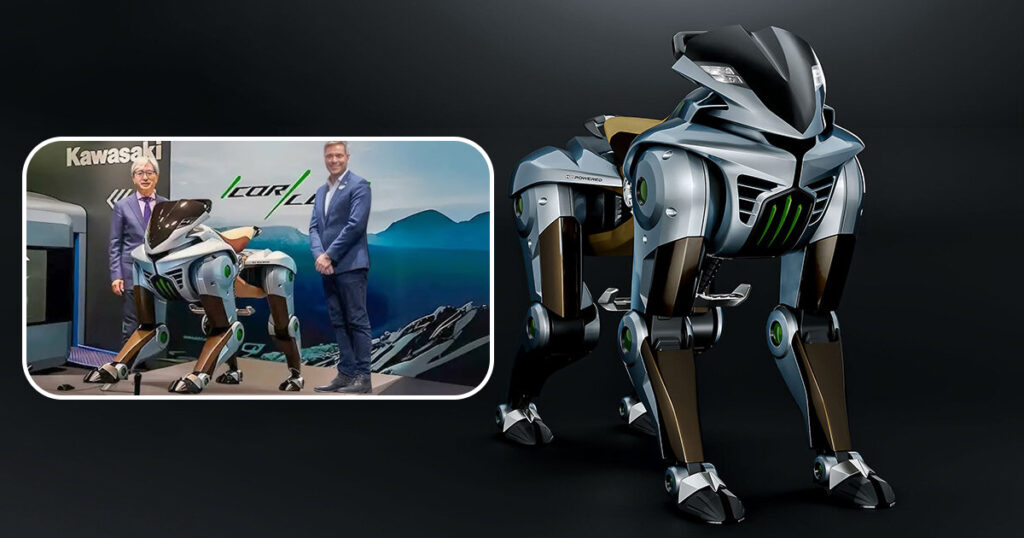Kawasaki’s CORLEO Robot
In a groundbreaking move toward sustainable and futuristic mobility, Kawasaki has unveiled the CORLEO — a four-legged hydrogen-powered robotic vehicle designed for human riders. Introduced at the Osaka-Kansai Expo 2025, the Kawasaki CORLEO robot is a unique fusion of motorcycle engineering, robotics, and eco-conscious technology. With the increasing focus on green energy and advanced personal transport systems, CORLEO is set to redefine off-road travel. Let’s dive into how Kawasaki is paving the way for a new era of mobility.
What Is Kawasaki’s CORLEO Robot?
The Kawasaki CORLEO robot is a four-legged, hoof-equipped vehicle powered by a hydrogen engine. It is built for one rider and is designed to navigate complex terrains with ease. Unlike traditional vehicles, CORLEO moves more like a mechanical horse or wolf, providing an organic and stable ride across uneven surfaces.
CORLEO’s highlight is its eco-friendly energy source. Instead of relying on traditional gasoline or diesel, the robot uses a 150cc hydrogen-powered engine that produces electricity, resulting in zero harmful emissions — only water vapor is released. This makes CORLEO a futuristic and sustainable option for adventure seekers and environment-conscious riders alike.
Key Features of the Kawasaki CORLEO Robot
- Hydrogen-Powered Efficiency The CORLEO uses hydrogen as its fuel, promoting a cleaner environment. The 150cc engine generates electricity internally, making the CORLEO a hybrid marvel that is both powerful and eco-friendly.
- Advanced Legged Mobility Each of CORLEO’s four legs ends in rubber “hooves,” allowing it to handle various terrains — from grassy fields to rocky landscapes and even rubble-strewn areas. Unlike wheels or tracks, legs provide greater adaptability and stability.
- AI-Powered Stability Using real-time artificial intelligence, CORLEO analyzes the rider’s movements and the surrounding terrain. This allows it to automatically adjust its gait, posture, and balance to provide a smooth and safe riding experience.
- Intuitive Control System Riders guide CORLEO by shifting their weight, with sensors located in the stirrups and handlebars detecting minute movements. This offers a natural and intuitive control mechanism that feels similar to horseback riding.
- Future Vision for 2050 Although CORLEO is currently in the conceptual phase, Kawasaki envisions its mass commercialization by 2050. The company aims to position CORLEO as a serious alternative for personal all-terrain transportation.
Why Is Kawasaki CORLEO a Game-Changer?
- Environmental Impact: With zero harmful emissions, CORLEO contributes to a greener planet.
- Mobility Redefined: It bridges the gap between robotics and transportation.
- Futuristic Design: CORLEO’s design combines functionality with aesthetic innovation.
- AI Integration: Real-time terrain analysis ensures maximum safety and adaptability.
The Kawasaki CORLEO robot symbolizes a future where robotics and sustainable energy go hand-in-hand.
How Kawasaki CORLEO Could Transform the Future
Imagine navigating rocky mountain trails, crossing grassy meadows, or exploring post-disaster urban areas — all without leaving a carbon footprint. CORLEO’s robust design and advanced AI promise not just leisure activities but also potential applications in disaster response, military logistics, and ecological research.
Additionally, Kawasaki’s investment in hydrogen technology positions the brand as a leader in the race toward carbon neutrality.
Summary:
Kawasaki’s CORLEO is not just a technological marvel but a bold statement about the future of mobility. Fusing robotics, AI, and sustainable hydrogen energy, the Kawasaki CORLEO robot offers a glimpse into how humans may interact with machines and the environment in the coming decades. As hydrogen infrastructure grows and AI becomes increasingly sophisticated, vehicles like CORLEO could become common sights in adventure sports, urban commuting, and beyond.
Stay tuned — the future is galloping toward us!
A: The CORLEO is powered by a 150cc hydrogen engine that produces electricity to move its legs.
A: While it is currently in the concept stage, Kawasaki expects to bring it to market by 2050.
A: CORLEO is designed to adapt to various terrains, including grasslands, rocky fields, and rubble.
A: Riders control it intuitively through body weight shifts detected by sensors in the stirrups and handlebars.
A: It runs on hydrogen and only emits water vapor, making it an eco-conscious alternative to fossil-fuel-powered vehicles.
